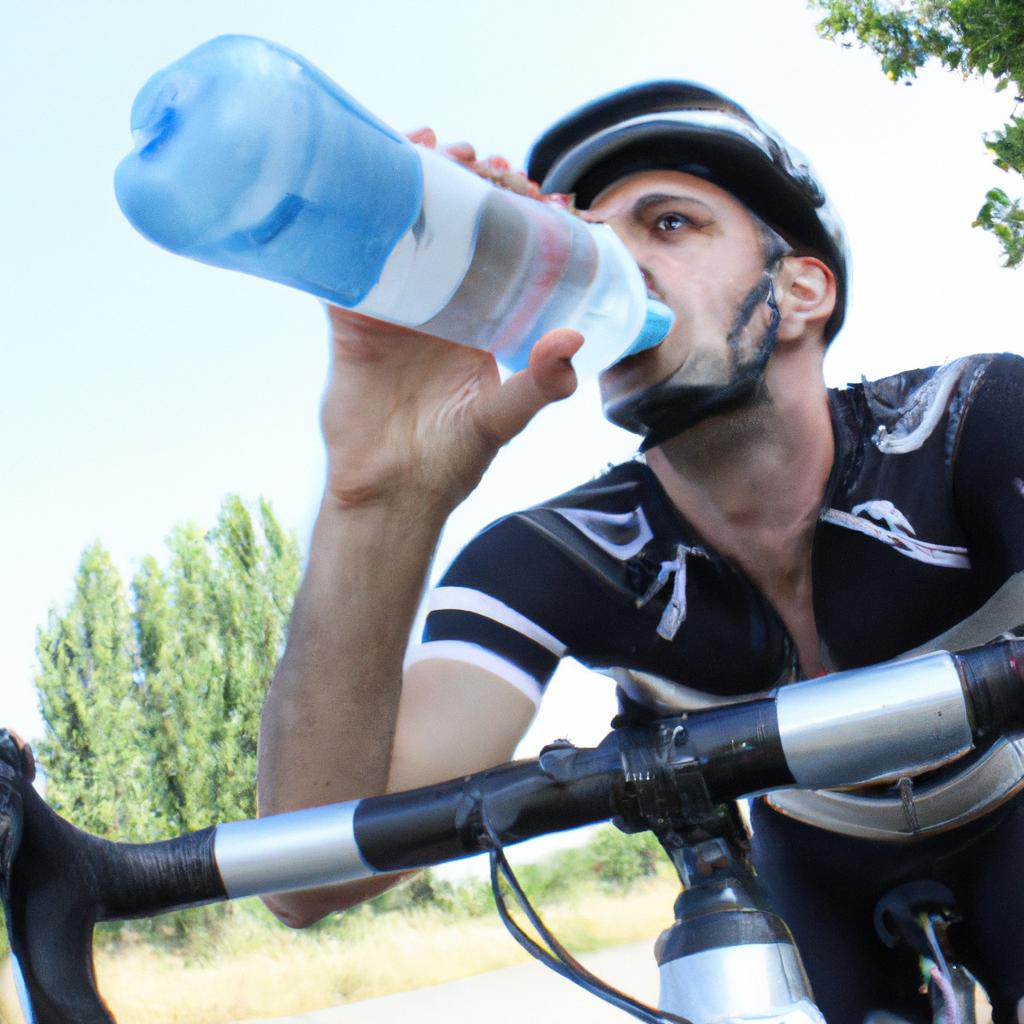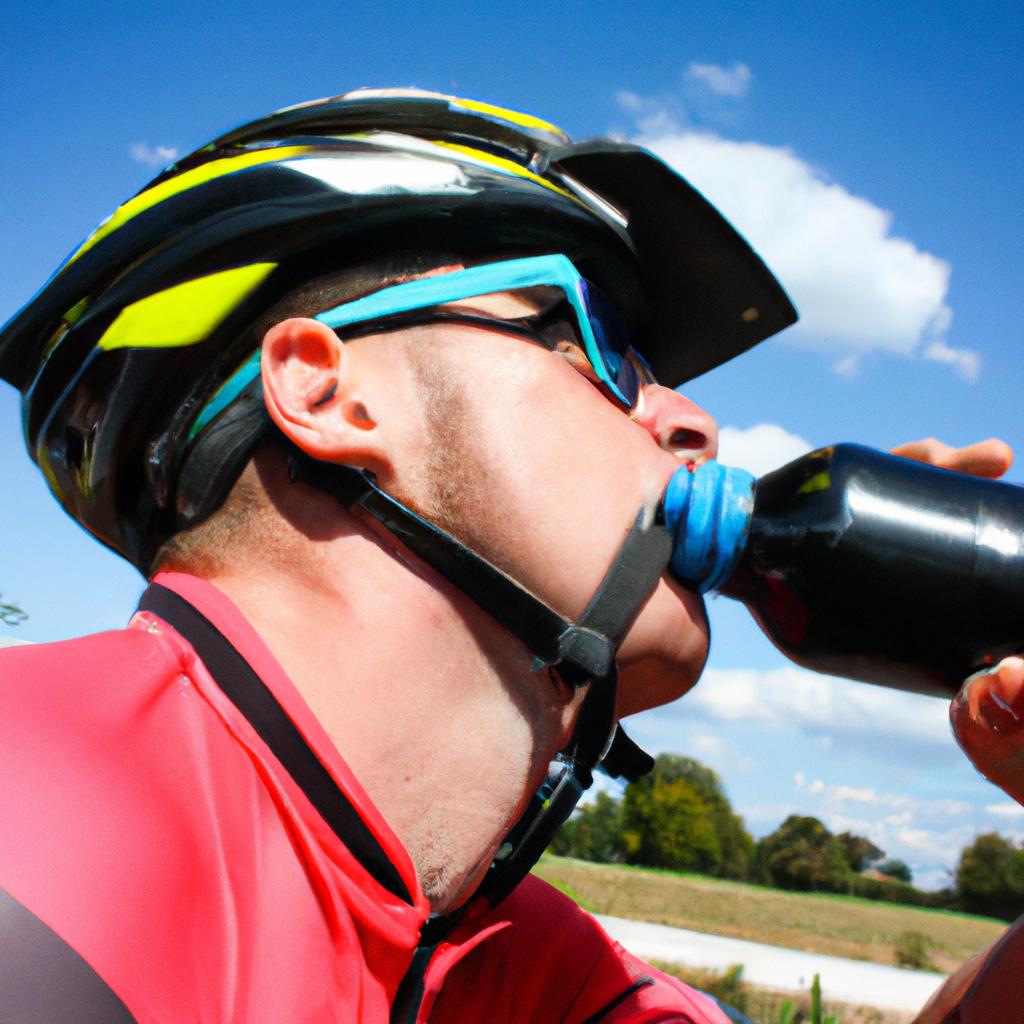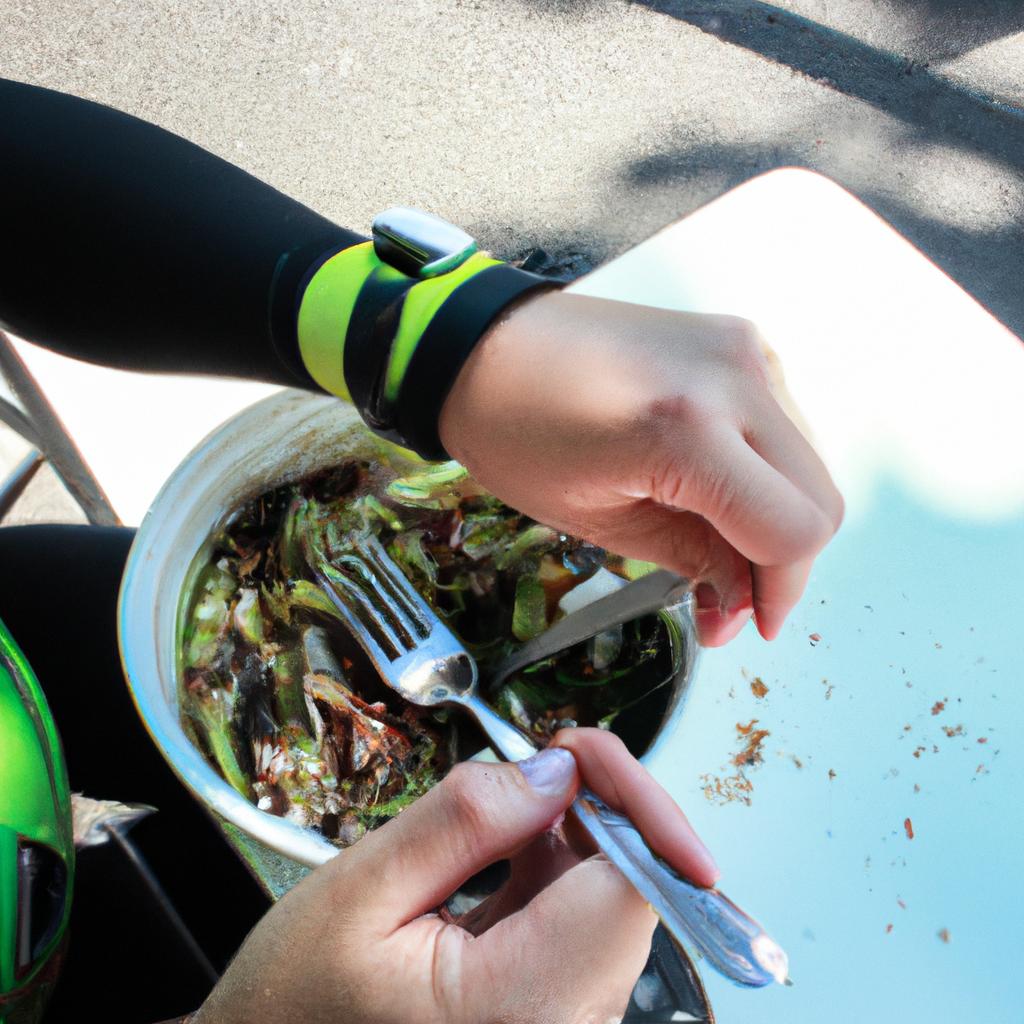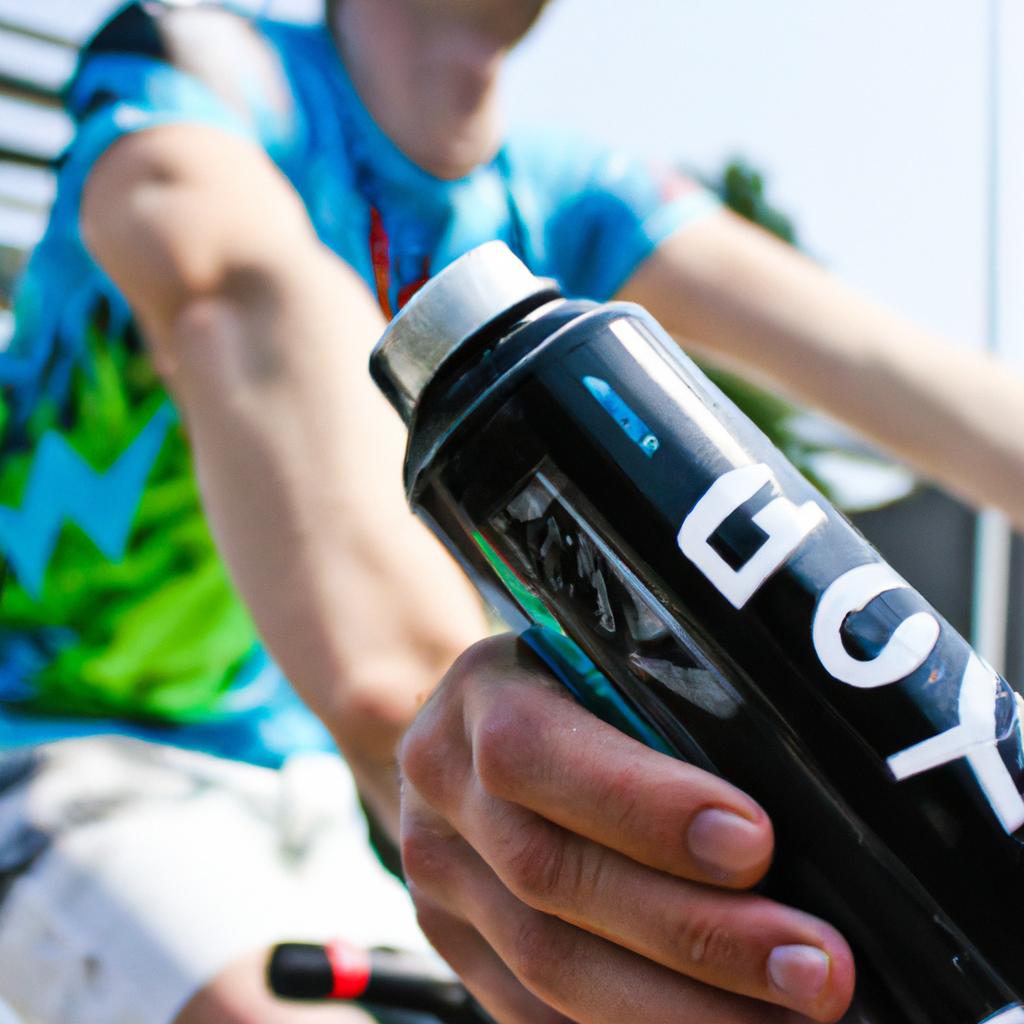Post-Ride Nutrition: Optimizing Cycling Performance
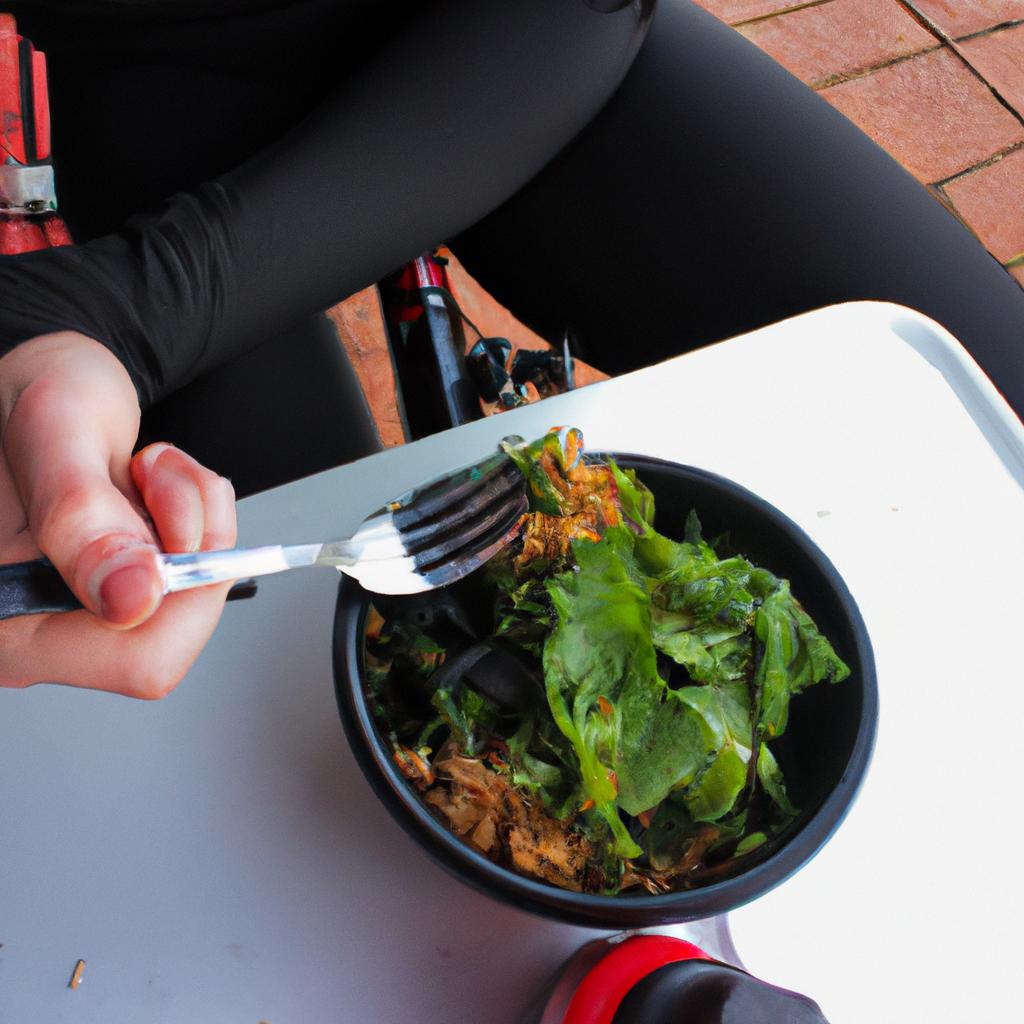
Post-ride nutrition plays a vital role in optimizing cycling performance. Properly fueling the body after an intense cycling session is crucial for replenishing glycogen stores, repairing damaged muscle tissue, and promoting recovery. For instance, imagine a scenario where two cyclists complete the same demanding ride but have different post-ride nutritional strategies. Cyclist A consumes a well-balanced meal rich in carbohydrates, proteins, and essential nutrients immediately after the ride, while Cyclist B neglects proper refueling and chooses to skip this important step altogether. The difference in their subsequent performances will likely be noticeable; Cyclist A may experience faster recovery times and improved overall performance due to adequate nutrient intake, whereas Cyclist B might suffer from fatigue, delayed recovery, and decreased endurance capabilities.
Understanding the importance of post-ride nutrition requires delving into its various components and how they contribute to optimal performance enhancement. Firstly, carbohydrates are key in restoring depleted glycogen stores within muscles and liver following strenuous exercise. By consuming carbohydrate-rich foods or drinks promptly after a ride, athletes can expedite glycogen resynthesis rates, thereby enhancing energy availability for future training sessions or competitions. Secondly, protein intake significantly aids in muscular repair by providing amino acids necessary for rebuilding damaged tissues resulting from the physical stress of cycling. Protein also supports muscle growth and adaptation, allowing cyclists to improve their strength and endurance over time.
In addition to carbohydrates and protein, post-ride nutrition should include essential nutrients such as vitamins and minerals that aid in overall recovery and immune system support. Antioxidants, found in fruits and vegetables, help combat oxidative stress caused by intense exercise, reducing inflammation and promoting faster healing. Hydration is also crucial during the recovery period, as it assists with nutrient absorption and replaces fluids lost through sweat.
Timing is an important factor in post-ride nutrition as well. It is recommended to consume a combination of carbohydrates and protein within 30 minutes to one hour after finishing a ride. This window of opportunity, known as the “glycogen synthesis window,” allows for optimal glycogen replenishment and muscle repair. Including some high-GI (glycemic index) carbohydrates can further enhance glycogen synthesis rates during this period.
Some examples of post-ride nutrition choices could be a turkey or chicken sandwich on whole-grain bread, a smoothie made with fruits, yogurt, and protein powder, or a balanced meal consisting of lean protein (such as salmon or tofu), complex carbohydrates (like quinoa or sweet potatoes), and plenty of vegetables.
Overall, prioritizing proper post-ride nutrition is essential for maximizing training adaptations, promoting recovery, preventing fatigue, and ultimately improving cycling performance.
Importance of replenishing glycogen stores
Importance of replenishing glycogen stores
Imagine a scenario where an avid cyclist, Sarah, embarks on a challenging 100-kilometer ride. Throughout the journey, she pushes herself to the limit, expending vast amounts of energy in order to conquer steep hills and maintain a fast pace. Upon completion of her ride, Sarah feels physically drained and fatigued. This real-life example highlights the importance of replenishing glycogen stores after intense physical activity.
The significance of glycogen replenishment:
Glycogen serves as the primary fuel source for endurance activities such as cycling. During exercise, muscles rely heavily on these stored carbohydrates to sustain performance. However, prolonged or high-intensity exercise leads to depletion of glycogen reserves within muscles, resulting in fatigue and decreased athletic performance. It is crucial for athletes like Sarah to take immediate action to restore their depleted glycogen levels following strenuous rides.
- Improved recovery: Replenishing glycogen allows for quicker recovery by providing a readily available energy source for subsequent workouts.
- Enhanced muscle repair: Adequate glycogen restoration supports protein synthesis and aids in repairing damaged muscle fibers.
- Optimized adaptation: By promptly refueling with carbohydrates after exercise, athletes facilitate optimal physiological adaptations that lead to improved endurance.
- Reduced risk of injury: Proper glycogen replenishment helps prevent overuse injuries caused by compromised muscular function during subsequent training sessions.
| Carbohydrate Type | Glycemic Index (GI) | Rate of Resynthesis |
|---|---|---|
| High GI | >70 | Rapid |
| Moderate GI | 56-69 | Moderate |
| Low GI | <55 | Slow |
By consuming carbohydrates with a higher glycemic index, athletes can expedite the restoration of their depleted glycogen stores. This knowledge empowers cyclists like Sarah to make informed dietary choices that optimize recovery and performance.
Understanding the importance of replenishing glycogen stores lays the foundation for comprehending another crucial aspect of post-ride nutrition: the role of protein in muscle recovery.
Role of protein in muscle recovery
To optimize cycling performance, replenishing glycogen stores is crucial for sustained energy levels during rides. However, another key factor that often goes overlooked is the role of protein in muscle recovery. Adequate protein intake post-ride plays a vital role in repairing and rebuilding damaged muscles, ultimately enhancing overall performance.
Example scenario:
Consider a hypothetical case where two cyclists completed an intense 50-mile ride at similar speeds. Both riders consumed an adequate amount of carbohydrates to replenish their glycogen stores after the ride. However, one cyclist also focused on consuming a protein-rich meal within the recommended timeframe post-exercise. Let’s delve into how this additional step can make a significant difference in terms of muscle recovery and subsequent cycling performance.
The Importance of Protein in Muscle Recovery:
- Repairing muscle damage: During prolonged or high-intensity exercise, muscle fibers experience microscopic tears and breakdowns. Consuming protein-rich foods provides essential amino acids necessary for repairing these damaged tissues.
- Stimulating muscle growth: Protein consumption stimulates muscle protein synthesis, which leads to the growth and development of lean muscle mass. This not only aids in recovery but also contributes to improved strength and power output.
- Reducing muscle soreness: Post-ride muscle soreness is a common complaint among cyclists due to the repetitive nature of pedaling movements. Studies have indicated that sufficient protein intake can help alleviate muscular discomfort and accelerate recovery time.
- Enhancing immune function: Intense exercise places stress on the body’s immune system, making athletes more susceptible to infections and illnesses. Adequate protein consumption post-ride supports immune function by providing the building blocks needed for antibody production.
| Benefits of Adequate Protein Consumption |
|---|
| – Optimal repair of damaged muscles |
| – Increased muscle growth |
| – Reduced post-ride soreness |
| – Strengthened immune system |
Incorporating protein into your post-ride nutrition plan is essential for maximizing muscle recovery and optimizing cycling performance. By providing the necessary amino acids, protein consumption aids in repairing damaged muscles, stimulating growth, reducing soreness, and supporting overall immune function. However, it is important to remember that individual needs may vary based on factors such as training intensity and body composition. In our next section, we will explore hydration strategies for optimal performance during rides.
Moving forward, let’s delve into effective hydration strategies for optimal performance during rides.
Hydration strategies for optimal performance
Understanding the crucial role that protein plays in muscle recovery, it is equally important to consider hydration strategies for optimal performance. Proper hydration not only replenishes lost fluids but also aids in maintaining electrolyte balance and preventing dehydration-related fatigue during cycling sessions. By implementing effective hydration techniques, cyclists can enhance their endurance and overall performance.
Hydration Strategies for Optimal Performance
To illustrate the significance of proper hydration, let’s consider a case study involving two cyclists who completed an intense 60-kilometer ride under identical conditions. Cyclist A consumed water throughout the ride while Cyclist B followed a strategic hydration plan. The results were strikingly different:
- Cyclist A experienced fatigue halfway through the ride, leading to decreased power output and slower finishing time.
- In contrast, Cyclist B maintained consistent energy levels, enabling higher power output until the end of the race.
Key components of a successful hydration strategy include:
-
Pre-hydration:
- Drink approximately 500 ml (16 oz) of water or a sports drink one hour before riding.
- This ensures adequate fluid reserves are established before exertion.
-
During-ride hydration:
- Aim to consume about 150-250 ml (5-8 oz) of fluid every 15-20 minutes during your ride.
- Choose isotonic drinks containing carbohydrates and electrolytes to maintain optimum hydration levels.
-
Rehydration post-ride:
- Within 30 minutes after completing a ride, aim to consume at least 500 ml (16 oz) of fluid along with carbohydrates and electrolytes.
- This helps replace fluid losses and promotes efficient muscle glycogen restoration.
By adhering to these guidelines, cyclists can optimize their performance and reduce the risk of dehydration-related setbacks.
Table: Electrolyte-Replenishing Snacks
| Snack | Potassium (mg) | Sodium (mg) | Magnesium (mg) |
|---|---|---|---|
| Bananas | 400 | 1 | 34 |
| Greek yogurt | 240 | 65 | 24 |
| Almonds | 200 | 0 | 80 |
| Watermelon | 170 | 3 | 20 |
Incorporating these snacks into your post-ride routine can aid in replenishing essential electrolytes, promoting faster recovery, and enhancing overall performance.
Now, let’s explore the benefits of consuming carbohydrates post-ride. By focusing on this aspect of nutrition, cyclists can further optimize their recovery process and improve their long-term performance.
Benefits of consuming carbohydrates post-ride
Transitioning from the importance of hydration strategies for optimal performance, it is essential to also consider the benefits of consuming carbohydrates post-ride. To illustrate this, let’s imagine a hypothetical scenario involving two cyclists who have just completed an intense training session. Cyclist A immediately replenishes their glycogen stores by consuming a carbohydrate-rich snack or meal, while Cyclist B does not prioritize post-ride nutrition and simply waits until their next regular meal.
The effects of these different approaches become evident when comparing the recovery and subsequent performance levels of both cyclists. Cyclist A experiences faster muscle glycogen restoration, allowing them to recover more quickly and efficiently. This leads to improved overall training adaptations, reduced risk of overtraining syndrome, and enhanced endurance capacity in future workouts or races. In contrast, Cyclist B may experience delayed recovery, increased fatigue, and decreased exercise performance due to inadequate glycogen replenishment.
To maximize your post-ride nutrition and optimize cycling performance, here are some key points to consider:
- Timing: Aim to consume carbohydrates within 30 minutes after your ride or race to take advantage of the body’s heightened ability to replenish glycogen during this time.
- Quantity: Consume approximately 0.8–1 gram per kilogram of body weight of easily digestible carbohydrates. For example, a 70-kilogram cyclist would aim for around 56–70 grams of carbohydrates.
- Quality: Choose nutrient-dense sources such as whole grains, fruits, vegetables, or sports drinks that provide not only carbohydrates but also important vitamins and minerals.
- Individualization: Tailor your post-ride carbohydrate intake based on factors like duration and intensity of exercise, body composition goals, and individual tolerance.
By following these guidelines for post-ride nutrition with an emphasis on adequate carbohydrate consumption, you can optimize your recovery process and set yourself up for continued improvement in cycling performance.
Incorporating healthy fats into your post-ride meal can further enhance the benefits of proper nutrition.
Incorporating healthy fats into your post-ride meal
Building on the importance of consuming carbohydrates post-ride, let’s now explore another vital component for optimizing your cycling performance – incorporating healthy fats into your post-ride meal. Imagine this scenario: after an intense cycling session, you sit down to refuel with a nutritious and well-balanced meal that includes healthy fats. Not only will this aid in your recovery process but it can also enhance your overall performance in subsequent rides.
Healthy fats play a crucial role in providing sustained energy, supporting muscle repair, reducing inflammation, and promoting cardiovascular health. By including these essential nutrients in your post-ride meal, you can reap their numerous benefits:
- Sustained Energy: Healthy fats such as avocados, nuts, and seeds are rich sources of monounsaturated and polyunsaturated fatty acids. These provide long-lasting energy by slowing down digestion and gradually releasing glucose into the bloodstream.
- Muscle Repair: Omega-3 fatty acids found in foods like salmon and chia seeds exhibit anti-inflammatory properties that aid in muscle repair and reduce exercise-induced soreness.
- Inflammation Reduction: Consuming omega-3 fatty acids helps combat inflammation caused by strenuous exercise. This facilitates faster recovery from workouts and reduces the risk of overuse injuries.
- Cardiovascular Health Support: Including heart-healthy fats like olive oil or flaxseed oil in your post-workout meal can contribute to maintaining optimal heart function and improving overall cardiovascular health.
| Type of Healthy Fat | Food Sources | Benefits |
|---|---|---|
| Monounsaturated | Avocado, Olive Oil | Provides sustained energy |
| Polyunsaturated | Nuts (almonds, walnuts), Chia Seeds | Aids in muscle repair and reduces inflammation |
| Omega-3 | Salmon, Flaxseed Oil | Combats inflammation, supports cardiovascular health |
By incorporating these healthy fats into your post-ride meal, you can optimize your recovery process and enhance your cycling performance. So, next time you reach for a snack or sit down to a meal after a ride, consider including foods rich in these essential nutrients.
Now that we understand the significance of incorporating healthy fats into our post-ride nutrition routine, let’s explore another aspect that plays a crucial role in maximizing its benefits – timing your post-ride nutrition for best results.
Timing your post-ride nutrition for best results
Transitioning from incorporating healthy fats into your post-ride meal, let us now delve into the importance of timing your post-ride nutrition for optimal results. To illustrate this concept, consider a hypothetical scenario where two cyclists complete an intense training session lasting 2 hours. Both individuals consume identical meals afterward, containing the same macronutrient composition and total caloric intake. However, one cyclist consumes their meal immediately after finishing the ride, while the other waits for an hour before eating.
Timing plays a crucial role in maximizing post-ride recovery and performance gains. Research suggests that consuming nutrients promptly following exercise can enhance glycogen resynthesis, muscle protein synthesis, and overall recovery rates (Burke et al., 2019). By providing your body with essential nutrients during this critical window of opportunity, you can optimize tissue repair and replenish depleted energy stores more efficiently.
To ensure timely nutrient delivery to your muscles, it is recommended to consume a balanced post-ride meal within 30 minutes to 1 hour after completing your cycling session. This timeframe allows for efficient absorption and utilization of carbohydrates, proteins, and other vital nutrients by your body. Additionally, consider the following guidelines:
- Carbohydrates: Aim for approximately 0.8 grams per kilogram of body weight within the first hour after exercise.
- Protein: Consume around 20 grams of high-quality protein to stimulate muscle protein synthesis effectively.
- Fluids: Rehydrate by drinking plenty of fluids to replace any losses incurred during sweating.
- Electrolytes: Include electrolyte-rich foods or beverages such as bananas or sports drinks to restore electrolyte balance.
To further emphasize the significance of proper post-ride nutrition timing on performance outcomes, consider the table below showcasing key benefits associated with prompt nutrient consumption.
| Benefits of Timely Post-Ride Nutrition |
|---|
| Enhanced glycogen resynthesis |
In conclusion, timing your post-ride nutrition is essential for optimizing cycling performance. By consuming a balanced meal within the first hour after exercise, you can facilitate glycogen replenishment, muscle repair, and overall recovery. Incorporating carbohydrates, protein, fluids, and electrolytes into this meal helps ensure that your body receives the necessary nutrients to support these processes effectively. Remember, prompt nutrient consumption can make a significant difference in your performance gains and long-term progress as a cyclist.
Reference:
Burke, L.M., Ross M.L., Garvican-Lewis L.A., Welvaert M., Heikura I.A., Forbes S.G., et al. (2019). A Low Carbohydrate-High Fat Diet During an Intense Training Period: Case Study With Elite Race Walkers. International Journal of Sport Nutrition and Exercise Metabolism, 29(4), 392-400.

